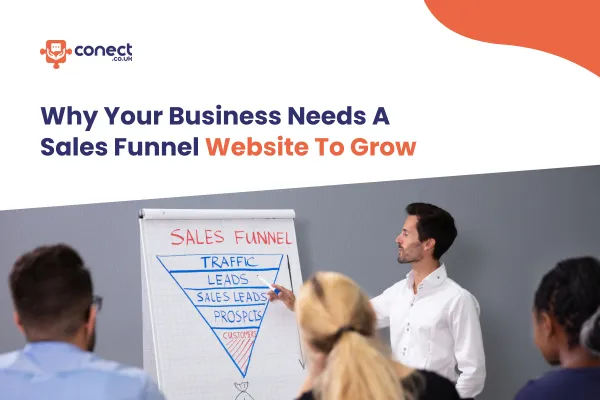
Boost Sales Fast with a Sales Funnel Website
Why Your Business Needs a Sales Funnel Website to Grow
A sales funnel website is more than just a digital trend—it’s a proven structure that directs visitors toward a single goal: becoming a customer. Unlike standard websites that offer many paths and distractions, a funnel website takes a visitor step-by-step through a clear journey designed to build interest, trust, and action. Whether you're selling physical products, offering services, or collecting leads, a sales funnel framework can dramatically increase your results.
Traditional websites often fail because they’re designed to be digital brochures. They show off everything the business offers but don’t give users a clear direction. Visitors might land on the homepage, scroll for a bit, click around, and leave. A sales funnel website, on the other hand, is engineered to keep attention and guide each person toward a specific outcome.
What Exactly Is a Sales Funnel Website?
A sales funnel website is a digital system that mimics the sales process used by top-performing marketers. It starts with grabbing the visitor’s attention, then builds curiosity, adds value, and ultimately encourages action. Unlike a cluttered homepage with multiple links, a funnel keeps things simple and focused.
It usually follows this structure:
Landing Page: Offers a clear, strong message.
Lead Magnet or Offer Page: Encourages users to share their contact details.
Sales Page: Explains benefits and builds desire.
Checkout Page: Simplified buying process with limited distractions.
Thank You Page: Confirms the action and may offer a secondary option (like an upsell).
By walking users through this process, you reduce bounce rates and increase conversions.
Sales Funnel vs. Traditional Website: The Clear Difference
Let’s look at how a typical website and a funnel website function differently.
Traditional Website:
Visitors can go in many directions.
Contains multiple service pages, blogs, and links.
No clear focus or goal.
Higher chance of confusion and drop-offs.
Sales Funnel Website:
Focuses on one goal (buy, book, sign up).
No top menu or distractions.
Clear, guided steps from action entry.
Optimized for conversion.
This shift from “show everything” to “guide action” can be the reason some businesses grow fast while others stay stuck.
The Psychology Behind High-Converting Funnels
Sales funnels are built using psychological triggers proven to increase action. Here are the most effective ones:
Urgency: Deadlines and countdowns encourage people to act fast.
Scarcity: Showing limited quantities or seats creates a fear of missing out.
Authority: Testimonials and expert quotes build credibility.
Social Proof: Real reviews and user numbers increase trust.
Commitment and Consistency: Small actions (like entering an email) lead to bigger ones (like buying).
Clarity: A single message and CTA avoids mental overload.
These tactics aren’t manipulative—they’re based on how people make decisions. When used ethically, they guide users toward the best solution for their needs.
Real Results: Funnel Websites That Outperform
Let’s look at a real-world example. A digital service company built two versions of its landing page. The first was a traditional homepage with links to services, blog articles, an about page, and a contact form. The second was a dedicated sales funnel focusing on one service—offering a free 30-minute consultation.
Results after 30 days:
Traditional homepage: 3.2% conversion rate
Funnel website: 7.1% conversion rate
That’s over twice as many leads using the same ad budget. Why? Because the funnel removed distractions and made the decision easy.
Now imagine scaling that over a year—this business could generate hundreds more leads without spending extra on ads.
Must-Have Features in a Sales Funnel Website
A funnel is only as strong as its weakest link. That’s why every step needs to be optimized. Here are the key features that make a funnel work:
1. A Bold, Benefit-Focused Headline
Your visitor should understand in seconds what you offer and how it helps them.
2. Engaging Visuals
Use high-quality photos or videos that highlight the solution, not just the product.
3. Clear Value Proposition
Explain why your offer is better, faster, easier, or more effective than others.
4. Social Proof
Add genuine testimonials, ratings, and success stories. People trust people.
5. Strong Call to Action (CTA)
Your CTA should be direct, like “Get Your Free Trial” or “Book a Call Now.”
6. Lead Capture Form
Keep it short and friction-free. Only ask for what you need (name, email).
7. Mobile Optimization
A funnel that’s hard to use on mobile is a funnel that fails. Optimize every page.
8. Follow-Up Automation
Use email sequences to build trust and follow up with leads who didn’t convert right away.
The Best Tools to Build a Sales Funnel Website
You don’t need to hire a full development team. There are tools built specifically for sales funnels:
ClickFunnels: Great for beginners and marketers who want fast results.
Kartra: Offers everything from pages to email and automation.
Systeme.io: Simple interface, great for coaches and digital creators.
Leadpages: Excellent for lead-gen funnels and integrations.
WordPress + Elementor or Thrive Themes: Perfect if you want more control and customization.
Pick the platform that fits your technical skills and business model. All of these are more suitable for funnel-building than traditional website tools.
Businesses That Gain the Most from Funnel Sites
Not every business needs a massive website with ten pages and blog content. These industries see incredible results with a sales funnel website:
Coaches and Course Creators: Sell programs directly from a simple funnel.
Consultants and Freelancers: Book discovery calls with qualified leads.
E-commerce Brands: Use upsells and downsells to increase order value.
Health Clinics and Therapists: Schedule appointments faster and reduce no-shows.
Event Organizers: Drive ticket sales with urgency-based offers.
If your goal is more leads or sales and less “window shopping,” a funnel is a smart move.
Cost vs. ROI: Is It Worth Building a Funnel?
Some business owners hesitate to invest in a funnel because of the cost. But when you compare that to the return, the value becomes clear. A good funnel can:
Increase your conversions by 2X or more
Reduce your ad spend per lead
Automate your lead follow-up
Qualify users before they speak to you
Even if a funnel takes a few hours to build and $100/month to run, the ROI could be thousands per month in extra revenue. That’s what makes it a smart investment, not just a fancy feature.
Common Mistakes That Kill Conversions
Avoid these funnel-killing errors:
Asking for too much info too soon: Keep your forms short and sweet.
Weak or confusing headlines: Your headline should explain the core benefit instantly.
Too many CTAs: One page, one action. Keep it focused.
No follow-up emails: Not every visitor will buy right away. Nurture leads.
Ignoring mobile users: Always test on smartphones and tablets.
A high-converting funnel is simple, clear, and driven by user behavior, not just a pretty design.
Signs You Need a Sales Funnel Website Right Now
Still unsure if this is the right move? Ask yourself:
Are you getting traffic but no leads?
Are your ads not converting?
Are visitors landing and leaving without action?
Do you spend time chasing leads that go cold?
Is your current site confusing or outdated?
If you answered yes to any of these, a sales funnel website could be the most important upgrade you make this year.
How a Sales Funnel Website Supports Paid Advertising
Running paid ads without a strong funnel is like pouring water into a leaky bucket. You might get clicks, but conversions remain low. A sales funnel website ensures that every visitor who clicks your ad lands on a page built specifically to match their interest and guide them to take action.
When your funnel is aligned with your ad’s promise, users experience a smooth transition from curiosity to decision. This increases your return on ad spend (ROAS) and allows you to scale your campaigns more confidently.
Marketers using dedicated funnel landing pages report conversion increases of 30% or more compared to generic websites. That difference alone could mean thousands in extra monthly revenue from the same ad spend.
Funnels Aren’t Just for Selling—They Build Trust Too
One of the biggest misconceptions is that funnels are only for pushing sales. In reality, a well-built funnel also educates, builds trust, and qualifies leads. The steps within a sales funnel website can include free resources, email nurturing sequences, and even interactive elements like quizzes to guide decision-making.
By offering value at each step, you warm up cold traffic, establish credibility, and make your offer feel like a natural next step. This is especially powerful for service-based businesses where trust is critical before purchase. The funnel becomes not just a sales tool, but a relationship-building system that works 24/7.
Conclusion
A sales funnel website is not just a new way to design web pages. It’s a smarter way to grow your business. Instead of hoping visitors figure things out on their own, a funnel gives them a clear path from curiosity to conversion. If your current website isn’t getting results, it may be time to switch to a model that’s built for performance and designed for growth.
FAQs
1. What is the purpose of a funnel-based website?
It guides visitors step-by-step toward taking action, like signing up or making a purchase, boosting conversions.
2. How is this type of site different from a regular website?
Unlike standard websites, it’s built with a clear journey in mind, reducing distractions and improving sales flow.
3. Do small businesses benefit from funnel sites?
Yes, they help small businesses convert limited traffic into leads or customers more efficiently.
4. Can I build one without tech skills?
Yes, many drag-and-drop tools make it simple to create one without needing to code or hire a developer.
5. How long does it take to see results?
Many businesses notice improved engagement and conversion rates within weeks of launching a focused funnel site.

The All-In-One Solution to grow your business. Capture Free Leads And Conversationally Covert Them Into Customers!
Contact information
Address : Layton Lane, Rawdon, Leeds, LS19 6RG
Phone : +44 7859 775480
Email : [email protected]
© 2025 Butterfly Effect Marketing Ltd - All Rights Reserved.

